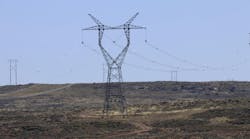The features of the existing power system in Russia’s northern territories, which are subject to severe climatic conditions, have been developed as a result of the historical evolution of the region. The Yamal Autonomous Region (YAR) is located in the northern central part of the Eurasia continent. The high-latitude position of this territory, its remoteness from the warm air as well as from the water masses of the Atlantic and Pacific oceans, and the flat-land open penetration of air masses from the Arctic in the summer and from the continent in the winter all form the acutely continental climate. The temperature ranges between -70°C to 30°C (-94°F to 86°F). Moreover, the average wind speed equals 8 m/sec to 10 m/sec (18 mph to 22 mph), which could achieve 30 m/sec (68 mph) in peak season (March-April).
Drastic changes in the region’s power supply sector occurred in the 1960s as a result of a geological prospecting expedition established in the town of Salekhard, which is located on the polar circle. The region is now a center for existing and newly developed oil and gas production and processing enterprises. The power supply requirements for this expanding industrial development, regarded as the region’s baseload, prompted the need to upgrade the YAR region’s existing transmission system.
Existing Systems
The YAR region’s transmission system has a centralized zone that operates in parallel with the United Power System (UPS) of Russia as well as a decentralized zone. These two zones have similar characteristics in terms of the installed generating capacity and energy consumption. The majority of the consumers in the centralized zone are supplied by 220-kV and 500-kV transmission system overhead lines. These lines are long and subject to YAR’s climatic conditions.
The distribution networks in the decentralized zone supply residential settlements. These networks are predominantly 6-kV electric networks. Nevertheless, these consumers demand high network security and reliability standards. The growth of the YAR region’s power industry has resulted in the need to review and update the traditional methods for electric power system development planning.
YAR Demand
The transmission systems in the UPS of Russia cover only 30% of the YAR territory. Hence, a large number of autonomous electric power supply systems supply the energy needs of industrial, commercial and residential consumers. The total installed generating capacity of power stations in the YAR territory is 1639.4 MW, including 837.3 MW in the decentralized power supply zone. This relatively low level of centralization in the region is largely because of the complexity of the existing network construction required to supply the remote, geographically isolated residential settlements, and the oil and gas production and processing plants.
More than 80% of energy consumption in the YAR territory is taken by the petrochemical extraction plants and processing enterprises. The domestic consumption is less than 5% of the total annual electric power consumption on the YAR territory. This results in uniform typical daily maximum demand curves for YAR’s power system.
The striking feature of the typical daily demand curve for a summer day is the absence of a morning or evening maximum demand and the uniformity illustrated by the 0.93 ratio of the summer minimum and summer maximum demands. This uniformity is largely the result of predominant demand from industry and the length of daylight hours during the summer.
Terrain Influence
Because of the climatic features of the Yamal region, the swampy land terrain makes it difficult to execute network repair work. There is a marked difference between the average number of days when transmission line repair work can be completed by the UPS of Russia and JSC Tumenenergo — one of the largest interregional distribution grid utilities in Russia — in the YAR territory.
Because of the length of winter conditions in the YAR territory, the majority of repair work is completed during April and May, when the power demand is lower than in the autumn/winter period. Also, this time of year is favorable for repairs to be executed in the swampy terrain on the long 110-kV to 500-kV transmission lines. During the summer, the opportunity to do repair work is limited.
Planning Uncertainty
The feasibility study criteria for the development of the 110-kV and higher voltage networks in the YAR territory do not differ from traditional studies. The transfer capability of the interconnection transmission lines and the installed generation have to provide the necessary level of reliability to satisfy the specified power consumption forecast. The external power supply scheme has to correspond to the required standards of reliability for the connected consumers. Moreover, the parameters for the power and energy operating conditions have to satisfy the system security N-1 criteria under normal and emergency operational conditions. All these criteria must be satisfied by the most economical solution.
The feasibility studies undertaken to determine the development of 110-kV and higher voltage systems are based on verified design models. These include models for systems operating under different emergency conditions attributable to unplanned or fault outages and planned outages for maintenance works.
Development of the basic 110-kV and higher voltage transmission systems in any region functioning under conditions of the power branch liberalization is involved with high risks due to the uncertainty of initial data. This uncertainty of initial data arises from decisions made by the generating companies and some major consumers with regard to the implementation timing of their development.
The time taken for transmission system development considerably exceeds the development time for the generating utilities and consumers. Monitoring of the transmission system expansion in YAR revealed one of the projects constructed in 2014 became redundant in the short term because of the development time. The 220-kV Arsenal substation was built for industrial consumers. Between the planning and completion time, project consumers changed their plans for an external power supply and built their own generation capacities. At present, the new 220-kV Arsenal substation operates without load. This provides the transmission utilities in YAR the necessity of deploying additional projects and bearing additional costs for future years.
During the last two decades, the uncertainty of initial data has become traditional for all liberalized power systems. However, for regions similar to YAR, this risk has become even larger because the key moving force for the region is the development of new oil and gas fields as well as the extension of existing ones. Oil and gas production enterprises specify high requirements, including the date by which a reliable power supply provision is required. Frequently, they cannot wait for the connection to the UPS of Russia, preferring instead to seek an energy supply from an autonomous source.
To limit the risk of exposure to these problems, a predictive approach is used in the development planning studies whereby several scenarios are considered to take into account the specified uncertainties. These scenarios help to determine the economic losses associated with the defined risks. The coordination of the development scenarios for the power industry in YAR — including the forecast for electric power and energy consumption as well as the plans for generation and consumption growth — are prepared for a five-year-period development program.
Scheme and Program
The 2016-2020 scheme and program of the YAR electric industry presents the coordinated plan for the region’s development with regard to generating capacity power, electric networks operating at 110 kV and major consumers.
The scheme and program of the UPS of Russia development (SaPr of UPS of Russia), which at the federal level determines the development plans for generating power as well as the main electric network of 220-kV and higher voltage systems, is the basis for the regional program. It specifies the development of the 110-kV and higher voltage transmission systems network.
The program recommendations are as follows:
- Correction of the implementation dates for development of the 220-kV transmission system and generation included in SaPr of UPS of Russia as a result of detecting violations in the requirements to the power output schemes of power stations
- Measures for the technological connection of the new residential and industrial consumers
- Measures to provide reliable construction and operation of the 110-kV and higher voltage transmission systems
- Introduction of parameters for the electric power and energy operating conditions outlook within an acceptable tolerance range achieved as a result of installing new emergency automated devices.
Key Projects
Several key projects are under construction. The first project is the construction of a 220/110-kV Salekhard substation with 220-kV double-circuit overhead lines 359.4 km (223 miles) in length from Nadym substation to connect the isolated Salekhard power system. The second project is the construction of a 220/110-kV Iskonnaya substation with 220-kV overhead lines 8 km (5 miles) in length to improve the reliability level of the power supply of industrial and domestic consumers in Noviy Urengoy.
The third project is the construction of a 220-kV overhead line some 164 km (102 miles) in length to provide an interconnection between the Iskonnaya and Arsenal substations to exclude limitations of the power output of existing and planned power stations.
The fourth project is the construction of a 220-kV, 250-MVA Ermak substation, a 220-kV, 50-MVA Slavyanskaya substation and two 220-kV overhead lines 215 km (134 miles) in length to supply new gas, oil and mineral extraction plants. And the fifth project is to provide switching facilities on the existing 220-kV Mangazeya to Vankor overhead line to interconnect the isolated Vankor power system.
Each year, the program will be executed in accordance with the new plans established by the generation utilities, consumption forecasts and regulator’s policy. The main goal for the future is to achieve a balanced development plan that will provide stable expansion of the power sector in the Yamal region.
Petr Antonov is the head of power expansion block in JSC “STC UPS” with responsibility for mid-term power system expansion planning. Antonov is therefore responsible for coordination of these plans between the generation companies, transmission system operator, large consumers and the executive authorities.
Konstantin Nikishin is deputy chief engineer of JSC “STC UPS.” Nikishin’s main scientific interests are demand forecasting and transmission and distribution systems research and development. He holds a bachelor’s degree, master’s degree and Ph.D. from the Urals Federal University, Yekaterinburg, Russia.











